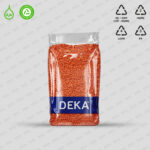Dry Food Packaging
Dry Food Packaging

All Curiosities About Dry Food Packaging
Materials such as PE (Polyethylene), OPP (Oriented Polypropylene) and CPP (Cast Polypropylene) are commonly used in dry food packaging. As these materials have different properties, the areas and purposes for which they are used in packaging design can also vary.
1. PE (Polyethylene):
Polyethylene is a widely used material in the plastic packaging industry. PE is preferred for its properties such as flexibility, durability and water resistance. The use of PE in dry food packaging is generally preferred to protect the contents from external factors (moisture, air, etc.). PE can also be used as an inner lining material in various types of packaging.
2. OPP (Oriented Polypropylene):
OPP is obtained as a result of the orientation process of polypropylene material. This material is often used in printed packaging and has a glossy surface. OPP performs well in protecting against external factors and can increase the shelf life of the product. OPP is often used in the packaging of products such as biscuits and crackers.
3. CPP (Cast Polypropylene):
Cast polypropylene is produced by melting and molding polypropylene. CPP is a material resistant to high temperatures and suitable for refrigerator freezer conditions. Due to these properties, it can be preferred in the packaging of frozen foods and hot products.
Each material has its advantages and disadvantages. Packaging design should be based on product characteristics, storage conditions and consumer expectations. The choice of material should take into account factors such as preserving the freshness of the product, promoting the product effectively and providing convenience to the user.


